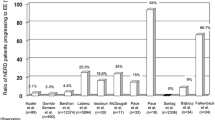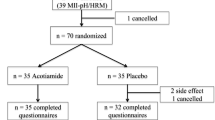Abstract
▴ Lansoprazole is a proton pump inhibitor that inactivates the H+/K+-ATPase pump in parietal cells, thus inhibiting gastric acid secretion and increasing intragastric pH.
▴ In an open-label, uncontrolled trial in children aged 1–11 years with gastro-oesophageal reflux disease (GORD), treatment with lansoprazole 15 or 30mg (depending on weight) once daily for 8–12 weeks improved symptoms compared with baseline in 76% of patients (47 of 62) based on patient diaries and healed erosive oesophagitis (confirmed endoscopically) in all 27 children who had it at baseline.
▴ In adolescents aged 12–17 years with GORD, 8 weeks’ treatment with lansoprazole 15mg (in 64 patients with nonerosive disease) or 30mg (in 23 patients with erosive oesophagitis) once daily reduced the frequency and severity of symptoms by 63% and 69% compared with baseline, based on patient diaries. In this open-label, uncontrolled trial, 96% of evaluable patients with erosive disease (21 of 22) had mucosal healing by week 8, as confirmed by endoscopy; mucosal healing did not occur after an additional 4 weeks’ treatment in one patient.
▴ Lansoprazole was generally well tolerated in children and adolescents, with the most common treatment-related adverse events being gastrointestinal events and headache.

Similar content being viewed by others
Notes
The use of trade names is for product identification purposes only and does not imply endorsement.
References
Hassall E. Decisions in diagnosing and managing chronic gastroesophageal reflux disease in children. J Pediatr 2005; 146 (3 Suppl.): S3–S12
Rudolph CD, Mazur LJ, Liptak GS, et al. Pediatric GE reflux clinical practice guidelines. J Pediatr Gastroenterol Nutr 2001; 35 Suppl. 2: S1–31
DeVault KR, Castell DO. Updated guidelines for the diagnosis and treatment of gastroesophageal reflux disease. Am J Gastroenterol 2005 Jan; 100(1): 190–200
Barradell LB, Faulds D, McTavish D. Lansoprazole: a review of its pharmacodynamic and pharmacokinetic properties and its therapeutic efficacy in acid-related disorders. Drugs 1992; 44(2): 225–50
Spencer CM, Faulds D. Lansoprazole: a reappraisal of its pharmacodynamic and pharmacokinetic properties, and its therapeutic efficacy in acid-related disorders. Drugs 1994; 48(3): 404–30
Langtry HD, Wilde MI. Lansoprazole: an update of its pharmacological properties and clinical efficacy in the management of acid-related disorders. Drugs 1997; 54(3): 473–500
Matheson AJ, Jarvis B. Lansoprazole: an update of its place in the management of acid-related disorders. Drugs 2001; 61(12): 1801–33
TAP Pharmaceutical Products Inc. Prevacid (lansoprazole) package insert (US). July 2004 [online]. Available from URL: http://www.tap.com [Accessed 2005 Sep 25]
Gremse D, Winter H, Tolia V, et al. Pharmacokinetics and pharmacodynamics of lansoprazole in children with gastroesophageal reflux disease. J Pediatr Gastroenterol Nutr 2002; 35 Suppl. 4: S319–26
Gunasekaran T, Gupta S, Gremse D, et al. Lansoprazole in adolescents with gastroesophageal reflux disease: pharmacokinetics, pharmacodynamics, symptom relief efficacy, and tolerability. J Pediatr Gastroenterol Nutr 2002; 35 Suppl. 4: S327–35
Fiedorek S, Tolia T, Gold BD, et al. Efficacy and safety of lansoprazole in adolescents with symptomatic erosive and non-erosive gastroesophageal reflux disease. J Pediatr Gastroenterol Nutr 2005 Mar; 40(3): 319–27
Book L, Chiu Y-L, Pilmer B, et al. Effect of lansoprazole on intraesophageal pH in children with pathologic acid reflux [abstract no. S1276]. Gastroenterology 2002 Apr; 122 Suppl. 1: A197. Plus poster presented at Digestive Disease Week; 2002 May 19–22; San Francisco (CA)
Miner P, Katz PO, Chen Y, et al. Gastric acid control with esomeprazole, lansoprazole, omeprazole, pantoprazole, and rabeprazole: a five-way crossover study. Am J Gastroenterol 2003; 98(12): 2616–20
Armstrong D, Marshall JK, Chiba N, et al. Canadian Consensus Conference on the management of gastroesophageal reflux disease in adults-update 2004 [online]. Available from URL: http://www.cag-acg.org [Accessed 2005 Sep 23]
Stolte M, Meining A, Seifert E, et al. Treatment with lansoprazole also induces hypertrophy of the parietal cells of the stomach. Pathol Res Pract 2000; 196: 9–13
Stolte M, Vieth M, Schmitz JM, et al. Effects of long-term treatment with proton pump inhibitors in gastro-oesophageal reflux disease on the histological findings in the lower oesophagus. Scand J Gastroenterol 2000; 35: 1125–30
Faure C, Michaud L, Shaghaghi EK, et al. Lansoprazole in children: pharmacokinetics and efficacy in reflux oesophagitis. Aliment Pharmacol Ther 2001 Sep; 15(9): 1397–402
Tran A, Rey E, Pons G, et al. Pharmacokinetic-pharmacodynamic study of oral lansoprazole in children. Clin Pharmacol Ther 2002 May; 71(5): 359–67
Freston JW, Chiu Y-L, Mulford DJ, et al. Comparative pharmacokinetics and safety of lansoprazole oral capsules and orally disintegrating tablets in healthy subjects. Aliment Pharmacol Ther 2003 Feb 1; 17: 361–7
Gremse DA, Donnelly JR, Kukulka MJ, et al. A novel option for dosing of proton pump inhibitors: dispersion of lansoprazole orally disintegrating tablet in water via oral syringe. Aliment Pharmacol Ther 2004 Jun 1; 19(11): 1211–5
Tolia V, Ferry G, Gunasekaran T, et al. Efficacy of lansoprazole in the treatment of gastroesophageal reflux disease in children. J Pediatr Gastroenterol Nutr 2002; 35 Suppl. 4: S308–18
Franco MT, Salvia G, Terrin G, et al. Lansoprazole in the treatment of gastro-oesophageal reflux disease in childhood. Dig Liver Dis 2000 Nov; 32(8): 660–6
Tolia V, Johnston G, Stolle J, et al. Flavor and taste of lansoprazole strawberry-flavored delayed-release oral suspension preferred over ranitidine peppermint-flavored oral syrup in children aged between 5–11 years. Paediatr Drugs 2004; 6(2): 127–31
Tolia V, Han C, North JD, et al. Taste comparisons for lansoprazole strawberry-flavoured delayed-release orally disintegrating tablet and ranitidine peppermint-flavoured syrup in children. Clin Drug Invest 2005; 25(5): 285–92
Tolia V, Fitzgerald J, Hassall E, et al. Safety of lansoprazole in the treatment of gastroesophageal reflux disease in children. J Pediatr Gastroenterol Nutr 2002; 35 Suppl. 4: S300–7
Author information
Authors and Affiliations
Corresponding author
Rights and permissions
About this article
Cite this article
Croom, K.F., Scott, L.J. Lansoprazole. Drugs 65, 2129–2135 (2005). https://doi.org/10.2165/00003495-200565150-00005
Published:
Issue Date:
DOI: https://doi.org/10.2165/00003495-200565150-00005




